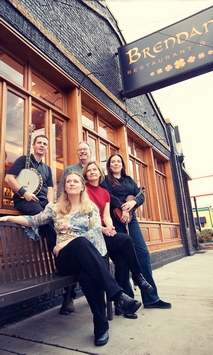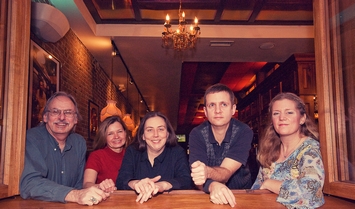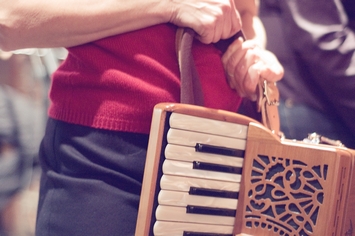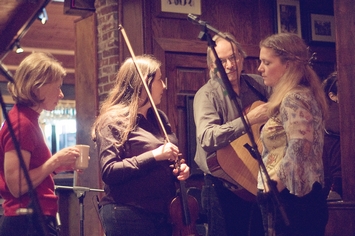social bookmarking tools:
 |
|
| Available RSS Feeds |
|---|
 - Top Picks - Top Picks |
 - Today's Music - Today's Music |
 - Editor's Blog - Editor's Blog
|
 - Articles - Articles
|
Add Louisville Music News' RSS Feed to Your Yahoo!
|

MY DARLING ASLEEP
ICH AM OF IRLAUNDE (SORT OF):
When we come to the end of time
To Peter sitting in state,
He will smile on three old spirits,
But call me first through the gate;
For the good are always the merry,
Save by an evil chance,
And the merry love to fiddle,
And the merry love to dance. . . .
-William Butler Yeats,
from "The Fiddler of Dooney"
It's called a "Bo Diddley": a two-bar count-off and intro, normally with three accented notes on the first two beats, followed by two more on the fourth. It sounds like "dat (really short pause), dat-dat (less of a short pause), dat-dat." If you're still having a hard time imaging what it sounds like (since the previous sentence probably looked like some kinked-up Morse Code), scrounge around to find the source: Bo Diddley's eponymous song from 1955. There are different versions of it, also, some adding a beat or two during the rests, others with a warble of reverb.
In Ben Andrews's studio in the Highlands neighborhood, the Louisville band My Darling Asleep is using a Bo Diddley as an intro to a traditional Irish foot-tapper called "Tell Me Ma." For a small portion of the song, the moist edge of a southern swamp in America seeps up to the entrance of a warm, rowdy pub in Cork and the anonymous fourteenth-century author scratches out his original lines and instead writes, "Come and hand jyvve wyt me / in irlaunde." One type of music meets its distant great-great-great-godparent.
Andrews has separated the band members into four booths: guitarist Henry Austin and banjoist Sean Mulhall in the one across from the master controls, violinist Rachel Blanton and accordion player Laurel Fuson in two smaller corner booths and vocalist Marion Halliday standing behind a microphone in the control room. They had been there since 10 that morning, rehearsing and tracking material for a forthcoming release. It was now more than eight hours later. Each member, obviously tired, lurched from his or her booth and began to pack up. Andrews promised a demo mix burned onto CD within a half an hour. Halliday had to leave quickly for a previous engagement.
"There's more Irish music around here than you realize," Mullhall said. The rest of us were in a Starbucks down the street from the studio, awaiting the call from Andrews that the mix would be ready. Music from the XM satellite station tailor-programmed for the chain knocked around the ventilation ducts in the exposed ceiling. Between that and the occasional bwisshhhh of the cappuccino machine, our conversation went on,

Mulhall continued. "There are four or five groups besides us. We're lucky now that the Irish music scene has been here for awhile. It's kinda had its ups and downs. Lately, I think it's been up, from what people tell me. I think that's largely because there are a couple or three places or so that will have us come and play."
Indeed, a half a block from where we sat is the closest thing a city might have that duplicates a street in Dublin or Cork: two blocks of taverns with Irish names that aren't just hyperreal EPCOT emulations of what authentic ones would look like. There's another one a few miles away in the heart of the St. Matthews neighborhood. And a few miles north of that is a restaurant started by an immigrant Irish couple that serves authentic pub food.
If, as the saying goes, that a pub is a poor man's university, then Louisville is has its own set of extension campuses. And the campuses need entertainment for the students. That's the job for Louisville bands like Guilderoy Byrne, Drowsy Maggie and others, including My Darling Asleep.
So it is appropriate that a band that provides entertainment for a non-traditional group of students who visit non-traditional universities to enjoy a pint or two got its start in academia.
"I teach at U of L at the music school," Mulhall said. "I started playing Irish music when I lived in New York and was going to graduate school. I came back here to teach and started an ensemble, of which Rachel was a member. She was a graduate student at the time. Marie Geever was also a student for a little while, but when we got the ensemble together she wasn't at the school. But she came in and helped out."
The ensemble grew to include 15 people. Mulhall and Geever later decided to perform on their own. To join them, they selected several of the ensemble's older players, including Blanton. For a band name, they looked to a traditional source: O'Neill's The Music of Ireland.
"Most Irish bands around the country," Mullhall explained, "their names are from tunes or maybe songs, or they have names that are Irish or Gaelic. I didn't want to do that. It seemed kind of pretentious to me. It works for some people."
"Some Gaelic names," Henry Austin added, "you can never know how to pronounce them and nobody can remember them."
"O'Neill's has a thousand tunes in it and I sat with Marie Geever and we went through every name. We narrowed the list to a few. She Googled them and ours wasn't taken."

The tune "My Darling Asleep" is a traditional Irish jig in 6/8 time in the key of D major, consisting of sixteen bars when transcribed, extended to a total of 32 with a pair of repeats, listed at number 925 in the O'Neill book. Easy to memorize and play on any instrument. And the tune's title makes for an enigmatic and attractive name. It's what brought Henry Austin in as the guitarist.
"Even before I was in the band," Austin said, "they were playing somewhere and [it was announced] on the radio and I thought that's a great name. I would really like to play in a band with that name."
Mullhall countered. "Then we heard about Henry Austin. We thought that was a nice name for a guitar player. Maybe someday we'll run into a Henry Austin."
A semi-retired therapist, Austin came into the group when another guitarist had left. Already a veteran of two other Irish bands, Glittering Strand and Tight Squeeze (which Blanton said she saw when she was a child), he, like the others of My Darling Asleep, had played another kind of music before his migration over to jigs and reels.
"My interest in this came through traditional dancing," he said. "I grew up in Lima, Ohio and was kind of on the rock-and-roll highway. It was fairly near Detroit and all these bands would come down. That's what my origin was. I played rock-and-roll for years, then moved here. My wife and I got involved with the Louisville Contra Dancers. There was not a group at the time. She and I and a bunch of other folks rejuvenated the group. It uses this kind of music, English and American fiddle tunes, too."
Laurel Fuson, a retired attorney, also came to the genre through a traditional dancing group. "We were called Scots Measure," she said. "I was in it for seven years with two other women. I got into it through Scottish dancing. And from that I discovered contra dancing. The same people seemed to do it. But there weren't any bands who played Scottish music. It has the same basic tunes, but it's a little different. We played for fancy Highland balls, where men would wear kilts."
Violinist Rachel Blanton had different reasons for engaging herself into Irish music. "I always liked folk and Bluegrass," she said. "I was looking for an outlet besides classical when Sean started the band. It was hard at first to not sound like a classical-trained violinist while playing Irish music."
Vocalist Marion Halliday, meanwhile, has been singing since childhood in church and madrigal choirs. While at Dartmouth College, she was a member of the Handel Society while also playing guitar and singing folk songs in small east-coast venues. Classicist by day, folkie by night, or vice-versa.
Fuson and vocalist Marion Halladay joined My Darling Asleep one year ago after Marie Geever, the original vocalist, left with her husband and son to live in Amsterdam. Fuson had known Austin for more than 20 years. The addition of the two women made a subtle, desirable alteration. "We knew we wanted to enlarge the group and add to our sound," Mulhall said. "So they pretty much joined at the same time. It kind of revamped everything."
This revamped lineup now consists of two retired professionals, a practicing corporate lawyer, a violin teacher and a university instructor. One is a classically trained musician, another started out in punk rock and was drummer for Louisville's Babylon Dance Band and two of them came into the music unintentionally by playing music for traditional dances.
But even with a couple members' experiences in playing for dances, My Darling Asleep (and other similar acts) tends to play strictly for their audiences' enjoyment, just like a regular pub band would.
"Here we don't play for dances as often as musicians in Scotland or Ireland do," Mulhall said. "Dancing to this kind of music can be the step dancing, which you see in Riverdance, or set dancing, the Irish or Scottish version of square dancing. Most of the tunes that we play are originally for dancing. But more and more bands from Scotland and Ireland are becoming more concert-oriented. And they'll take the tunes and the songs and mix them together."

"And there are different challenges with both," Austin said. "A dance is a different kind of thing than playing a concert. They're both fun. But in a dance your rhythm has to be very on. [The dancers are] listening to the beat."
"And the dancers don't care if you miss a note or not," Fuson added.
While those who perform the music know the distinctions are clear between music for a dance and music for a concert, between Irish and Scottish music (the time signature on the former can vary from 4/4 to a bouncy or waltzy 6/8, while the former is normally in a rigid 4/4 march) and the surprising difference between a song and a tune (one's longer with a definitive beginning and an end, while the other is a set of phrases repeated back and forth), some undiscerning ears might not be able to determine the distinctions and lump it all together as Celtic Music. But according to Mulhall, the term Celtic itself is merely a marketing category, merely a way to conveniently organize the music in a record store or in a catalog.
"There's no such thing as Celtic music," Mulhall said. "Celtic people, if they were a united people, lived all across northern Europe before the Romans conquered Gaul. There's Irish music, there's Scottish music, there's Welsh music, there's Galician music. These are areas where they used to speak in the Celtic language family. The musics have somesimilarities, but they're not the same. Celtic is a marketing term in this country. You don't see it much in Ireland or anywhere else."
Yet an explosion of interest in that genre is one reason there is such a marketing term, set off by one touring show: Riverdance. Celtic Womenhas helped, too.
"Most Irish musicians I've played with," Mulhall said, "said that Riverdancereally helped. There was this incredible increase in fans. People came out to see it or learned to play it or learned how to dance. It's not quite the phenomenon it once was, but every little bit of this stuff helps. If people have never really listened to this type of music before and they go see Celtic Womenand really like it, then on St. Patrick's day or some other time during the year, they'll go to Brendan's or Molly Malone's or Flanagan's or O'Shea's to hear it."
"Celtic Womenis more commercial," Austin said. "It's designed that way. They pick very pretty tunes. The women are very attractive. It's kinda new agey."
"This isn't like Britney Spears, totally manufactured," Mulhall said. "All of the performers are good players. They way they present it on stage is all very formal. They kinda fancy-up the traditional music."
Whether it's fancied-up, formal and designed for a large-scale stage production or stripped down for a packed tavern where the infectious rhythm makes people feel like they want to dance on the tables, Irish music has its fans and its own slate of superstars, such as Natalie McMaster and Ashley McIssac (who works modern downtempo grooves into his traditional sound). Other bands like Virginia's Carbon Leaf and Newfoundland's Great Big Sea also incorporate traditional Irish music into several of their songs.
"People grow up with this stuff in Chicago, New York, Ireland," Mulhall said, "and some of those players are brilliant. They're as good as any musician in any style. We have our own accomplishments, in a sense. But it's much easier if you've played other different styles of music. So if you've played classical, rock-and-roll, or dance music: what this says is that all those musicians out there, you don't necessarily have to grow up with this music. As long as you really have a passion for it and are sensitive about learning it the proper way, anyone can do it."
Like St. Patrick's Day, when we hear it or even play it, Irish music makes us all Irish, even if only for just a few minutes.
It makes us merry and want to dance.
My Darling Asleep performs this month at Brendan's on March 2 and 16 at 6 p.m., at Molly Malone's on March 17 (St. Patrick's Day) at noon, then at Flanagan's at 4 p.m.
Sean Mulhall is also music director of the Louisville Irish Fest, which this year will be part of the Ryder Cup celebration, on September 13 and 14 on the Belvedere.
Rachel Blanton, who arranged The Beatles Love for the cast jam band for Abbey Road on the River, will this year do the arrangements for a performance of the "White Album." This year's Abbey Road on the River runs from May 22 through the 26.
Marion Halliday will still practice corporate law. Henry Austin and Laurel Fuson will still be sort-of retired.
Find our more at www.myspace.com/mydarlingasleep.
